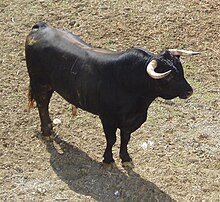Spanish fighting cattle
As a Spanish fighting cattle ( toro de lidia ) different are Iberian cattle breeds referred. One of the breeding goals of these breeds is particular aggressiveness . The bulls are used for bullfighting . The Spanish fighting cattle, together with some other original cattle breeds, have a special phenotypic similarity to the aurochs , the ancestral form of most domestic cattle.
Origin and distribution area
The fighting cattle is common in Spain, Portugal, southern France and parts of Latin America. These cattle are mainly found in the west and south-west of the Iberian Peninsula. The Spanish battle cattle can look back on a long history. It is believed to go back to domestic cattle introduced by Celtic tribes . Between the 8th and 15th centuries, a kind of no-man's-land between the Muslim and Christian parts of the Iberian Peninsula was likely to have developed in which large numbers of semi-wild cattle lived. The most aggressive bulls were always selected from these for the bullfighting. A herd of these animals is first attested in the 14th century by texts from the Kingdom of Navarre . During the 18th century there was more targeted breeding. The most suitable animals were selected from the herds, which originally served primarily for meat production, and they were bred specifically for various forms of bullfighting. This created different lines, some of which differ greatly from one another. Analyzes of mitochondrial DNA indicate that the Spanish fighting cattle are more closely related to aurochs from southern Europe or other European domestic cattle than to aurochs from northern and central Europe. In addition, the fighting cattle are to a small extent also carriers of DNA haplotypes , which are likely to have their origin in Africa. Overall, this phenotypically very diverse cattle form is also characterized by great genetic diversity. It is not clear whether the Spanish fighting cattle can be traced back to domestic cattle, which were originally domesticated in the Middle East, or to cattle that were domesticated independently on the Iberian Peninsula.
Appearance and description

In their appearance, these cattle are still very similar to the wild form of domestic cattle, the extinct aurochs. Fighting cattle have an athletic body shape with a slim waist, curved back line and strongly pronounced shoulder and neck regions. The legs are also often long. The skull is proportionally large and long-snouted, it has the horns curved forward. These are similar to those of the aurochs in several ways: on the one hand, they are at a 60 ° angle to the skull, as in the Ur, and they usually have a very similar or identical curvature. Fighting bulls also have some game characteristics in terms of color, so the bulls are mostly black and the cows are reddish-brown. Often there is also a light eel line and a white bordered muzzle , as was the case with the aurochs. The skull of the bulls usually has curled forehead curls, the color palette of which can range from blonde to red-brown to black. All these characteristics make the Spanish battle cattle one of the most aurochs-like modern cattle breeds. As a result of breeding, however, there are also individuals with deviating characteristics. The breed is small-framed, adult bulls reach 500 to 650 kg in weight.
Breeding lines
The black fighting bull has been bred for 500 years, the breed goes back to ancient Celtic land strikes. The minimum weight for a fight is 460 kg. Most often, bulls aged 5 or 6 years are used. Younger bulls (Novillos) are used in fights with young heroes. There are several breeding lines of the Toro de Lidia, the Spanish fighting bull, which can differ in terms of their proportions or color. The wild-colored fighting cattle, however, are in the majority.
The most important breeding lines are:
- Cabrera
- Gallardo
- Miura
- Navarre
- Vazqueña
- Vistahermosa
Historical fighting bulls
- " Gordito "
- " Civilón "
- " Islero "
- " Murciélago "
Individual evidence
- ↑ a b Cis van Vuure: Retracing the Aurochs. History, Morphology and Ecology of an extinct wild Ox. Pensoft, Sofia et al. 2005, ISBN 954-642-235-5 .
- ^ O. Cortés, I. Tupac-Yupanqui, S. Dunner, MA García-Atance, D. García, J. Fernández, J. Cañón: Ancestral matrilineages and mitochondrial DNA diversity of the Lidia cattle breed . In: Animal Genetics. Volume 39, Issue 6, December 2008, ISSN 0268-9154 , pp. 649-654.



